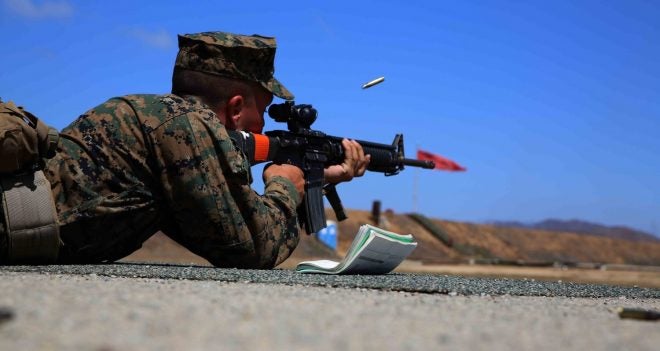The United States Marine Corps is looking for new advanced optics for rifles and IARs that are capable of switching between a low magnification mode and a high (6-8x) magnification mode, according to a recent request for information (RFI) released through FedBizOpps at the end of last month. The RFI, which solicits proposals from the industry but does not kick off bids for a contract, lists stringent requirements for the proposals, dubbed the “Squad Combat Optic”. SCO’s requirements include a 1-6 (or greater) power, ability to identify targets at 600m or more, a field of view of at least 18 degrees, and reticles designed for M4, M4A1, and M27 rifles firing M855A1 ammunition. Each requirement is painstakingly outlined in great detail, as shown in the excerpt below:
• Weight. Squad Common Optic should be less than or equal to 2.1 pounds (T), less than 1.4 pounds (O) including mount, turret caps, and battery.
• Size. Squad Common Optic should be less than or equal to 10.5 inches (T), 10 inches (O) in length excluding lens covers.
• The Squad Common Optic should be able to identify and acquire the target at 600m (T). The Squad Common Optic should be able to identify and acquire the target at 900m (O).
• Magnification Range. The Squad Common Optic should have no point of aim shift when adjusting through the entire magnification ranges. Squad Common Optic should have a magnification range of 1X +0.05X to ≥6X magnification range. The diopter should be adjustable from +2 to -2 diopters.
• Diopter Locking Mechanism. A locking mechanism should be provided on the diopter setting to prevent inadvertent movement (O).
• Adjustment Range. For all configurations, at least 15 milliradian (mrad) (T), and 30 mrad (O) in Elevation and at least 12 mrad in Windage adjustment should be required (T). There should be hard stops at both ends of Windage and Elevation adjustment and no dead clicks (T). A dead click is defined as a tactile adjustment click that does not move the reticle.
• Adjustment Increments. Each Squad Common Optic configuration should have adjustment increments less than or equal to 0.2 mrad Elevation and Windage (E/W). Adjustment increments on both E/W should be consistent in movement, tactile, and have no dead clicks and require no settling rounds. Settling rounds are defined as host weapon live fire that causes the reticle to move initially but stabilize after the live fire event.
• Adjustment Accuracy. For Squad Common Optic, a less than or equal to 2% adjustment accuracy should be required across the full travel in Windage and Elevation (T) and a less than or equal to 1% adjustment accuracy should be required across the full travel in Windage and Elevation (O).
Currently, the weapons in the USMC rifle squads use a combination of 4x magnification Rifle Combat Optics (RCOs) based on the Trijicon TA31 ACOG, as well as 3.5x magnification Squad Day Optics (SDOs) based on the Trijicon TA11, on the M249 SAWs and M27 IARs. A new variable power optic would allow the replacement of both of these scopes with a single device, and the unmagnified setting would substantially improve close range target engagement speed for close quarters battle scenarios.
 Your Privacy Choices
Your Privacy Choices
